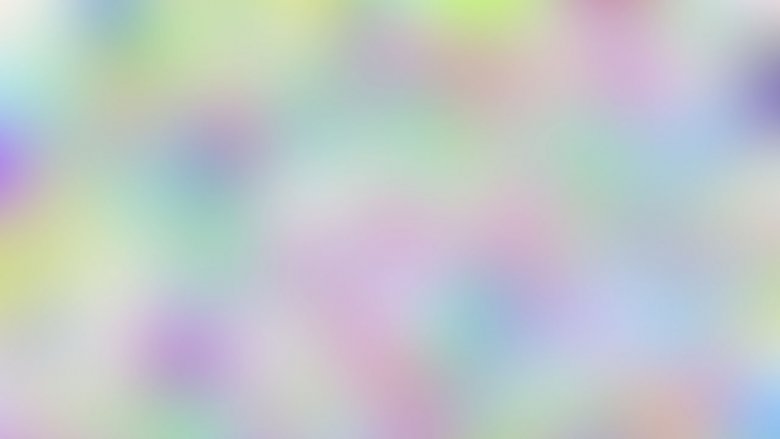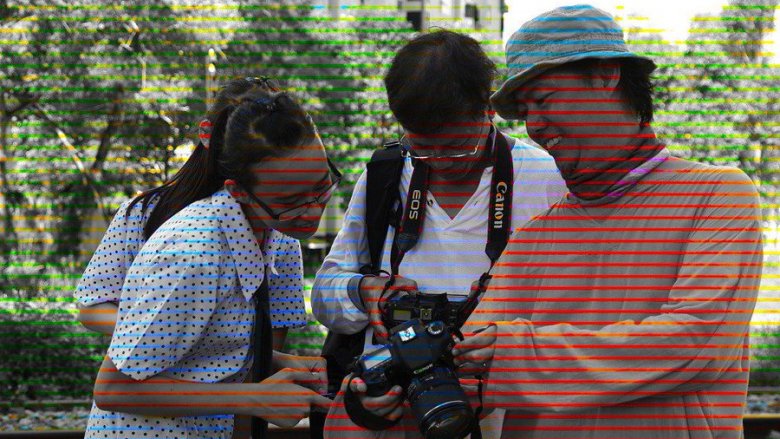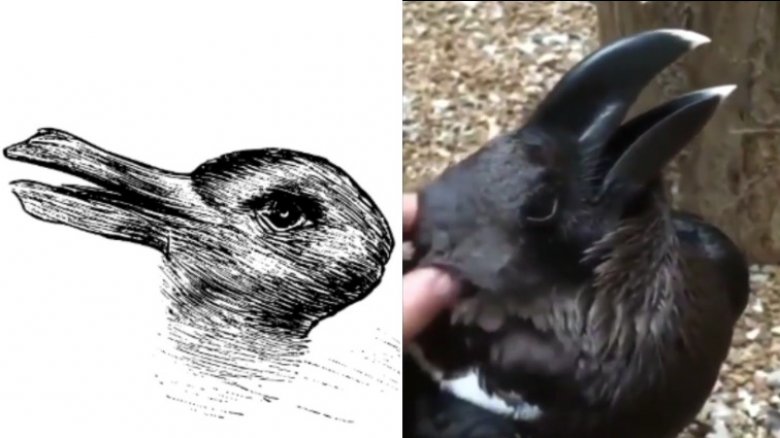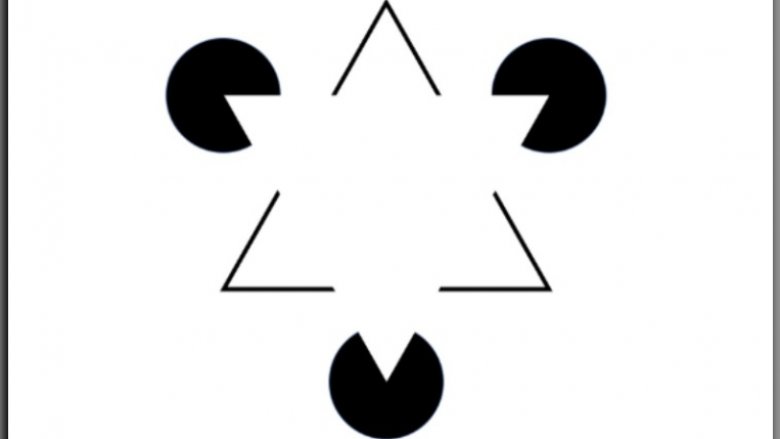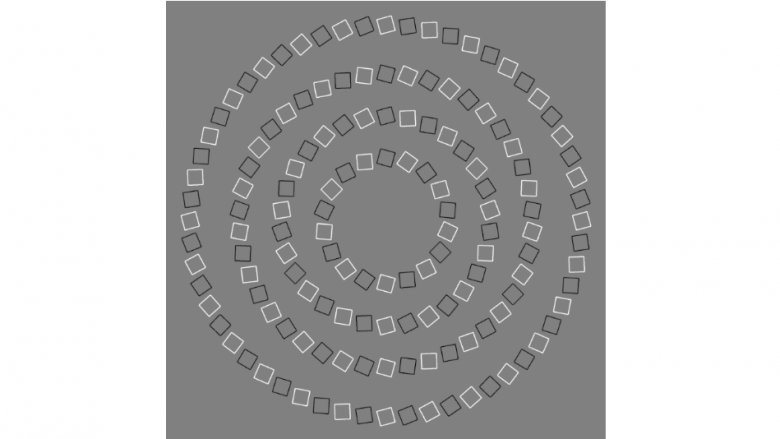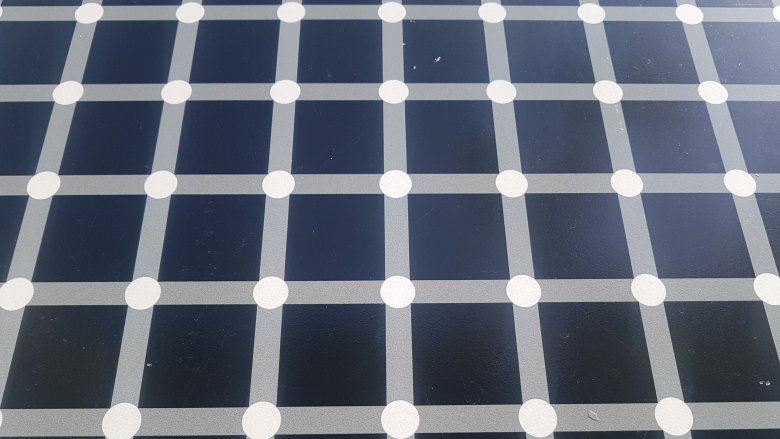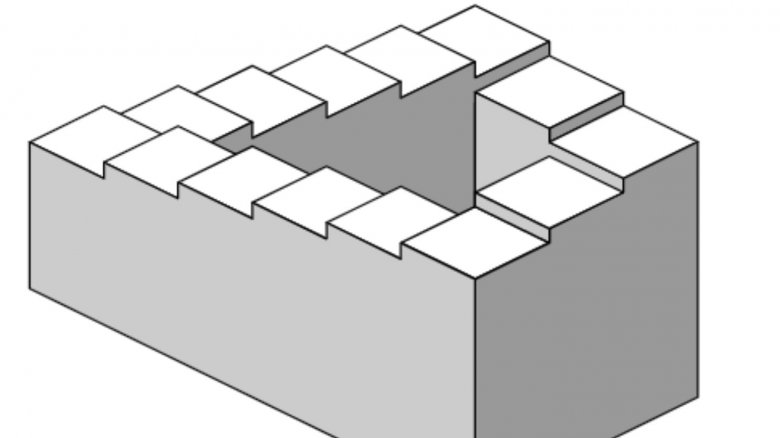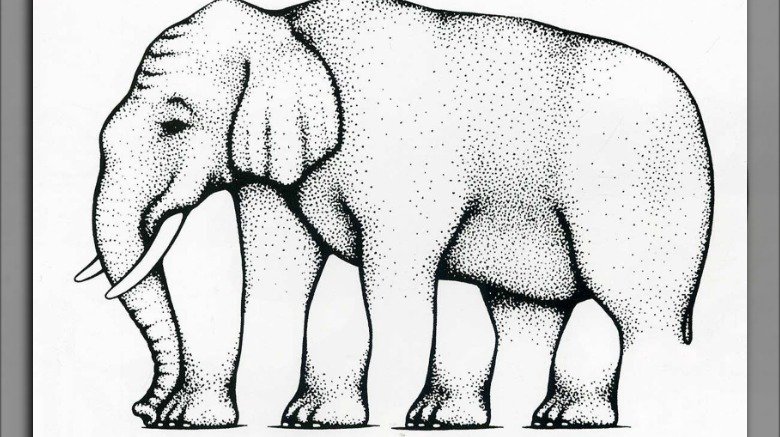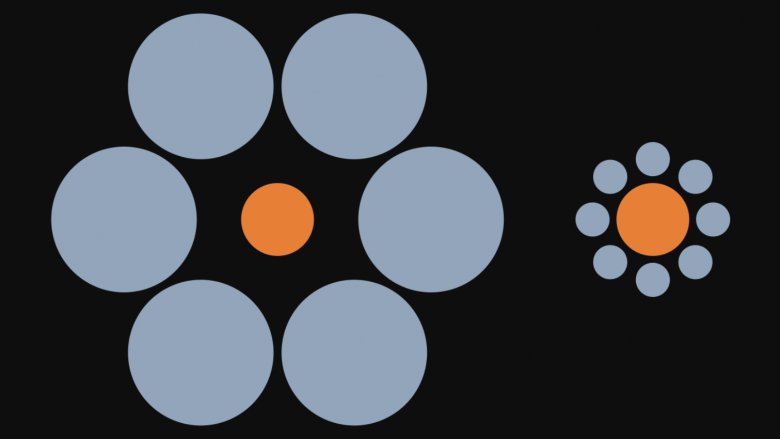Optical Illusions That'll Fool Your Brain
The above image might help explain why the Titanic sank. No, there's no hidden iceberg in the picture, but rather a mirage that hides part of the road. According to Smithsonian magazine, on the night the Titanic met its icy demise, that same kind of optical illusion, caused by abnormal light refraction, may have happened on a massive scale, hiding the iceberg behind a false horizon until it was too late.
That might seem like an indictment of the human visual system. But the very mechanisms that may have led to that historic tragedy are also possibly vital to human existence. As neurobiologist Mark Changizi put it, "The brain is always constructing things, which is helping you survive. Some of these constructions can be fiction." Humans need to make sense of a messy, uncertain world using imperfect eyes and imperfect brains. That's where optical illusions come in. And as you're about to see, you can also get a lot out of them.
The hollow face illusion is full of assumptions
Above is a mask of Albert Einstein that proves perception is relative and he equals MC scary. Initially, it looks like a dead-eyed Einstein is staring right at you. But when the presenter in the video rotates the mask, you discover that you were looking at the hollow (concave) side. Turn the mask left, and the concave face seems to turn right. Tilt the mask down, and Einstein looks up at you with his creepy, lifeless eyes.
This phenomenon is known as the hollow face illusion, and it's a brilliant illustration of top-down processing. Per University College London, top-down processing occurs when your brain relies on prior experience and context to interpret sensory information. Instead of seeing a weird, concave face, you overrule your eyes and think it's a normal, outward-pointing (convex) face. A less terrifying version of top-down processing happens during texting when a typo gets interpreted as a word that makes sense in context.
The hollow face illusion has been used to study cognitive impairment. With the aid of brain scans, UK and German researchers determined that people with schizophrenia "see through [the illusion], probably because their brain disconnects 'what the eyes see' from what 'the brain thinks it is seeing.'" People high on pot also see the hollow face, which may mean THC decreases top-down processing.
The Ames room has a door to Mount Doom
Sir Ian McKellen is a giant in the acting world, but he seems even bigger in Middle-earth, where he towers over hobbits. For context, IMDB lists McKellen's height as 5'11 and that of his furry-footed co-star, Elijah Wood, as 5'6. Yet as Frodo, Wood looks downright bite-sized next to McKellen's Gandalf. Given the prevalence of CGI effects in modern movies, you might assume that the Lord of the Rings and Hobbit trilogies used computer wizardry to make Bilbo, Frodo, and the dude from Rudy look tiny. But as the above video reveals, the movie magic was inside you all along.
It all boils down to forced perspective. Frodo only looks smaller because he's much farther away from Gandalf while being filmed from an angle which masks their true distance. Cosmos explained that this is an application of the classic Ames room illusion. Built by visual physiologist Adelbert Ames in the 1940s, Ames rooms duped viewers into believing they were seeing a rectangular enclosure when in reality, "one end of the room's back wall is much closer to the viewer than the other, and the ceiling is steeply sloped." The book Sensation and Perception mentioned that the person closer to the viewer (for example, Gandalf) also appears to fill up more space, making them look larger.
Troxler fading can turn mirrors into horror movies
Even if you've never attempted a magic trick in your life, a talented magician lives right inside your skull. Don't believe it? Just stare at the above image for 30 seconds or so. Did your brain make those pretty colors disappear? See? (Or rather, don't see?) Magic.
This optical trick is called Troxler fading or the Troxler effect, named for Swedish physician, politician, and philosopher Ignaz Paul Vital Troxler, who discovered the phenomenon in 1804, according to Newsweek. The colors fade as a natural consequence of your brain's tendency to "automatically [filter] out unchanging stimuli." This makes perfect evolutionary sense from the standpoint of detecting predators in the environment. If you're looking for a moving threat, there's no point in wasting brainpower on something inanimate.
Troxler fading can play terrifying tricks on your brain. Psychology Today described a study by the University of Urbino's Dr. Giovanni Caputo, who had participants "stare into a mirror in dim lighting for ten minutes." The subjects saw enormous distortions, "fantastical and monstrous beings," or even "an unknown person." A 2014 paper by Caputo noted that these so-called "strange-face illusions" occur far more frequently for some schizophrenics, who tend to believe the monstrous reflection is accurate. However, such distortions could also serve as a form of therapy for body dysmorphia sufferers.
Simultaneous contrast will make you see things differently
The basic idea behind simultaneous contrast can be illustrated with this timeless Mitch Hedberg joke: "I was going to have my teeth whitened, but then I said f*** that, I'll just get a tan instead." Mitch's teeth are sort of like the two inner rectangles above. Those shapes are the same shade of gray, but the rectangle with darker surroundings looks lighter while the one with lighter surroundings looks darker, just as you would expect Mitch's teeth to look whiter after he got a tan or darker if he were paler.
Per the Encyclopedia of Color Science and Technology, simultaneous contrast was discovered by French chemist Michel-Eugène Chevreul in the 19th century. While heading the dye department of a manufacturer, he was tasked with investigating an internal complaint from weavers about the dye quality. Chevreul determined that the issue wasn't the dye but the human eye. The colors simply looked different with different surroundings. What causes simultaneous contrast? According to ThoughtCo, the illusion stems from lateral inhibition, during which excited neurons in your retina suppress the activity of neighboring neurons, causing you to perceive stronger distinctions between objects. In other words, science.
The von Bezold spreading effect adds a little color to your life
The world isn't black and white, but this photograph is. That looks like a color photo, but what are you gonna believe — us or your lying eyes? To be clear, there is a modicum of color, but as Digital Spy described, it isn't coming from the photo itself, but rather a series of colored parallel lines overlaying the picture. Posted to Twitter in 2019 by artist Øyvind Kolås, this image demonstrates the von Bezold spreading effect, commonly referred to as color assimilation.
This illusion isn't new. Colour: How to Use Colour in Art and Design explains that in the 19th century, rug designer Wilhelm von Bezold realized "he could alter the entire appearance of his rug designs by simply changing a single color." Specifically, when he applied an even distribution of "black or white or a pure hue (at full intensity)," the rug's other colors would appear more similar to the new hue. Similarly, the black and white photo appears to have the colors of the lines placed over it.
Per the Journal of Vision, this is the opposite of what happens in simultaneous contrast, which causes colors to appear less similar to their surroundings. Research suggests that having "uniform" surroundings promotes contrast while stripes elicit assimilation. Moreover, stripe thickness makes a difference, with wider lines causing contrasts.
Ambiguous images show how impressionable perception is
Beauty is in the eye of the beholder, and so are birds and bunnies. Behold the two beauties above. Are they rabbits or birds? Let's start with the picture on the left, which Live Science described as an example of an ambiguous image. The illusion debuted in a German humor magazine in 1892 and was used as a research tool by U.S. psychologist Joseph Jastrow in 1899, per the Independent. Some people see a rabbit looking to the right while others perceive a duck looking to the left. However, Jastrow noted that more people see it as a rabbit closer to Easter time and as a duck in October.
Your interpretation of an ambiguous image might also conform to verbal descriptions, which brings us to the image on the right. That's a screenshot taken from a video that confused the internet in August 2019. CNN reported that a Norweigian scientist tweeted the footage with the caption, "Rabbits love getting stroked on their nose." That sentence was apparently enough to make many people see a strange-looking bunny getting his face nub rubbed. Many others saw what it actually was — a bird.
The color constancy illusion makes your eyes tell white lies
Just look at all those succulent gray strawberries. You read that right. And perhaps right now, you're joining the legions of internet naysayers who called shenanigans, certain that their eyes would never deceive them about something so obvious. Yet as Vice pointed out, a Twitter user proved the pixels are gray with a hint of green.
What you're witnessing is a fundamental element of perception called color constancy. Per Current Biology, "Color constancy is the tendency of objects to appear the same color even under changing illumination." Strawberries will still look more red than not, even when you color them greenish gray, and a banana will appear to be some form of yellow under various lighting conditions. Nonhuman animals such as bees, fish, and monkeys also have eyes that lie this way.
And thank goodness for those colorful falsehoods. How else would we consistently identify dangerous plants and animals that are associated with specific color patterns, such as the brightly colored, "highly venomous" coral snake? And could you imagine a world where strawberries drastically changed color based on ambient lighting? People would go bananas.
Illusory contours allow you to read between the lines that don't exist
The upside-down triangle in the middle of the image doesn't exist. The edges are all in your head. It's almost like seeing a geometric ghost, which is appropriate, since those Pacman shapes seem to be eating it. Psychologists call this the Kanizsa triangle, a classic example of illusory contours. ScienceDirect explained that illusory contours are a response to specific configurations of "outline figures," such as those black Pacman shapes that seem to form the corners of the Kanizsa triangle. Your brain is pretty picky about the specifics. In fact, if those same Pacmen were hollow outlines instead of solid black, you probably wouldn't see an upside-down triangle because "unfilled outline figures do not effectively evoke illusory contours."
Some experts think your brain implements a kind of visual checklist when determining whether to produce the illusion. What purpose would that serve? The book How Animals See highlighted a plausible hypothesis by V. S. Ramachandran, who proposed that illusory contours act as an "anti-camouflage device." Such a mechanism certainly sounds useful for detecting potential predators or prey that attempt to blend into the environment. That might also explain why a diverse array of animals, including honeybees, owls, and cats are capable of perceiving illusory contours.
The intertwining illusion will make your brain go in circles
If someone wanted to make a visual metaphor for despair, it might look something like this chain of alternating black and white boxes that seem to spiral into a blank gray oblivion. But what that spiral really represents is deception because that depressing image, dubbed the intertwining illusion, isn't a spiral at all but rather a series of concentric circles. MIT researcher Alvin Raj characterized the illusory spiral as an error by your peripheral vision, which "does not accurately keep track of all the visual details." As a result, you're more likely to see a spiral at the outer limits of your vision while it's easier to see a circle at the center of where you're staring.
Evolutionary anthropologist Mark Changizi couched the illusion in terms of the patterns a human might see in 3D space. Specifically, he argued that the tilt of the squares is more indicative of a spiral pattern and that real-world spirals tend to result from something going in a circle while moving away from you, which the illusion mimics. It's also worth noting that the real world is littered with spirals. The famous Fibonacci spiral pattern, for instance, is found in pineapples, pine cones, sunflowers, hurricanes, galaxies, many animal shells, and even DNA molecules. Heck, flushing a toilet produces a watery spiral — and possibly another metaphor for despair.
The Hermann grid illusion looks different to diabetics
Could you imagine if bathroom tiles looked like this? People with a fungus phobia might spend countless hours trying to eradicate what look like disappearing, reappearing mold spots. Luckily, this is just the brainchild of German physiologist Ludimar Hermann, who fathered this famous grid in 1870, per Inverse. There are no dark spots at the intersections, just your chronically confused peripheral vision.
As outlined in Sensation and Perception, lateral inhibition has long been the go-to explanation for the Hermann grid illusion. The basic idea behind that process, as described by ThoughtCo, is that neurons in the eye limit the activity of adjacent eye cells, enhancing perceptual contrasts. In fact, that underlying assumption served as the basis for a 2002 study published in the British Journal of Ophthalmology, which found that people with diabetes are less sensitive to the Hermann grid illusion. The researchers interpreted this to mean that diabetes impairs lateral inhibition, reducing sensitivity to contrast. But they may have been working with a faulty premise.
Other studies have shown that showing people a modified version of the Hermann grid which uses curvy lines doesn't create an illusion, which doesn't make sense if lateral inhibition is the primary driver. So what exactly is going on? We don't know, but fittingly, the answer probably isn't what it looks like.
The Penrose stairs lead to a weird insight about perception
Named after father-son mathematicians Lionel and Roger Penrose and elevated to pop cultural immortality by the brain-bending artwork of M.C. Escher, the Penrose stairs are visual gibberish. The staircase only leads to itself, yet the steps only go up. (Or, if you're a "glass half-empty" kind of person, they only go down) As Wired noted, this is physically impossible in the real world. Per PLOS One, theories of 3D perception usually assume that the stairs confuse your brain because 3D objects depicted on 2D surfaces lack clear visual info about distance. However, in 2012, researchers drew an unusual conclusion after having people judge the closeness of objects in an "immersive" virtual room that sometimes expanded dramatically.
In theory, the test subjects should have noticed the room's expansion, but they didn't, instead relying on the order in which they compared the objects to judge their closeness. The lead researcher observed, "In the impossible staircase illusion, you cannot tell whether the back corner is higher or lower than the front one as it depends which route you take to get there. The same is true, we find, in our task. This means that our own internal representations of space must be rather like Escher's paradoxes." Interestingly, an unrelated 2011 study provided evidence that depth-related visual cues may "play only a secondary role" in perceiving 3D objects.
An elephant illusion you'll never forget
Forget about Babar and Dumbo. There's only room for one famous elephant in this article, and that's Shepard's elephant. Just look at the leggy dude standing their with ... how many limbs exactly? Not to body-shame this big-eared beast, but it's got a wonky anatomy. In fact, its features are impossible.
Nature defined impossible objects as figures that "contain inconsistencies between global and local structure: while the local cues are valid, the resulting 3D global structure is incoherent and" doesn't follow the laws of real-world objects. Per the MIT Encyclopedia of the Cognitive Sciences, Shepard's elephant is impossible because it "confuses its legs with the spaces in between." However, since the animal's anatomy makes sense locally, when you cover the upper legs, you should see four normal feet. Conversely, cover the lower legs and feet, and you'll see four normal upper legs.
Experimental findings suggest that paying attention to visual information about an object's depth helps people discern whether that object's impossible. People don't seem to focus on depth information innately. Instead, it's a skill children hone for many years. Once it's learned, it's pretty much unforgettable, like the impossible elephant.
The Ebbinghaus illusion proves size matters in more ways than one
If you've ever seen one of those old Godzilla movies where a person dressed in a 200-pound floppy monster costume decimates a miniature city, then you know one of the ways to make something look really big is to surround it with really small things. What does that have to do with the Ebbinghaus illusion? Look at the two orange circles above. Which is bigger? You'd probably pick the one surrounded by smaller circles, but that's just Godzilla in a small-scale city. Conversely, the circle surrounded by far larger objects looks smaller and somehow wimpier. In reality, the orange circles are identical.
Named for German psychologist Hermann Ebbinghaus, the illusion not only illustrates how your brain judges an object's size in relation to nearby objects, it may also say something about the size of your brain's primary visual cortex (V1). Per National Geographic, researcher Samuel Schwarzkopf found that people with a smaller V1 are more susceptible to the Ebbinghaus illusion. Seen more broadly, the finding suggests that having fewer neurons dedicated to processing visual information might make you see the world less accurately. The strength of the Ebbinghaus illusion also varies across cultures. According to the Guardian, it affects Japanese people more strongly than UK residents. So maybe floppy Godzilla looks extra large in Tokyo.

